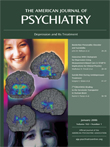Electric Sensations: Neglected Symptom of Escitalopram Discontinuation
To the Editor: We make reference here to a patient who experienced electric sensations after discontinuing escitalopram treatment.
Ms. A was first referred to our clinic by her family doctor for depressive symptoms (asthenia, insomnia) in the context of a psychosocial stress situation. Treatment with citalopram, 20 mg/day, was initiated, which was soon replaced by escitalopram, 10 mg/day, the enantiomer of citalopram. Because she was responding well, Ms. A reduced her dose to 5 mg/day and, 3 weeks later, stopped treatment altogether. About a week later, she began to experience electric shock-like sensations or visual flashes lasting for about 1 second each. This was followed by a phase of spatial disorientation that lasted for about 30 seconds and was experienced as highly unpleasant and frightening. The sensations were only felt when Ms. A was in an upright position; she had no history of loss of tonicity. These episodes occurred up to three times a day over a period of 2 weeks. Prodromal symptoms or specific triggers were not reported. While Ms. A was taking citalopram/escitalopram, no side effects were observed. Interactions with other substances could be eliminated because this was her only medication.
Ms. A’s depressive symptoms soon returned, resulting in more therapy with escitalopram (10 mg/day). She began to feel better and thus decided to reduce her medication, although it was well tolerated, to 5 mg/day and, after 4 weeks, again ceased taking it. One week later, the electric shocks reappeared, although they were now less intense. Ms. A’s family doctor continued to urge pharmacological intervention to treat her depression. However, she refused to cooperate out of fear of becoming addicted to antidepressants because of the sensations that she interpreted as withdrawal symptoms. An EEG as well as a detailed neurological examination revealed no abnormalities.
There is not much relevant literature on the subject of electric sensations as a discontinuation symptom of selective serotonin reuptake inhibitors and nothing at all in connection with citalopram or escitalopram, although comparable symptoms have been described as occurring after treatment with paroxetine and sertraline (1). The pathophysiology is not clear; the down-regulation of serotonin 5-HT2 receptors and the desensitization of both the 5-HT2 receptor transmembrane signaling system and the 5-HT autoreceptors seem to be of particular concern (2). There are two therapeutic options: resuming the medication and tapering it off even more slowly (2) or allowing the syndrome to run its course. However, the patient would need to be reassured that the symptoms are likely to disappear within 2–8 weeks without serious consequences. None has been reported so far (3).
1. Frost L, Lal S: Shock-like sensations after discontinuation of selective serotonin reuptake inhibitors (letter). Am J Psychiatry 1995; 152:810Medline, Google Scholar
2. Therrien F, Markowitz JS: Selective serotonin reuptake inhibitors and withdrawal symptoms: a review of the literature. Hum Psychopharmacol 1997; 12:309–323Crossref, Google Scholar
3. Black K, Shea C, Dursun S, Kutcher S: Selective serotonin reuptake inhibitor discontinuation syndrome: proposed diagnostic criteria. J Psychiatry Neurosci 2000; 25:255–261Medline, Google Scholar



